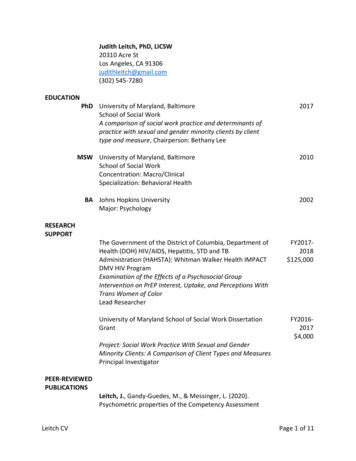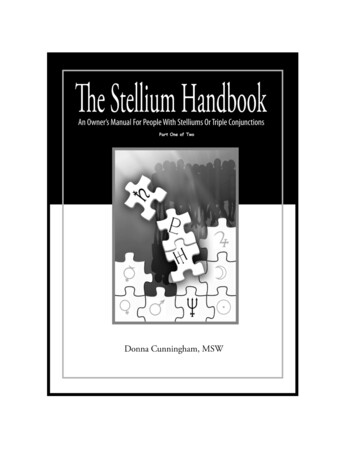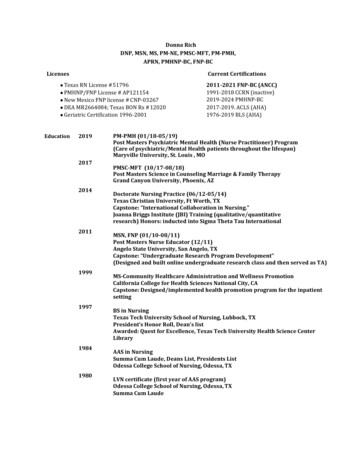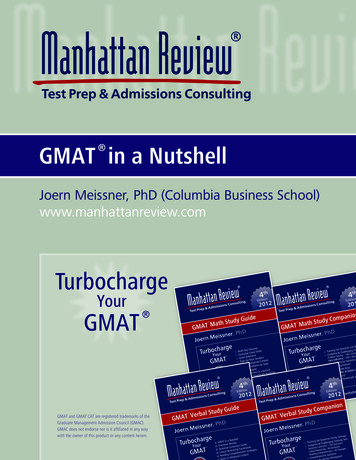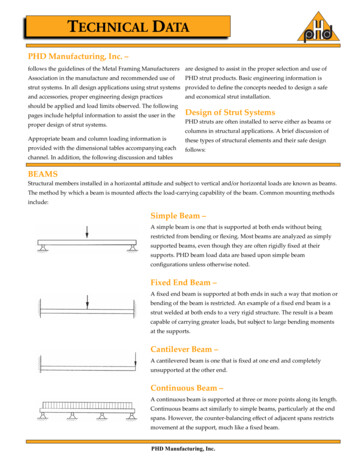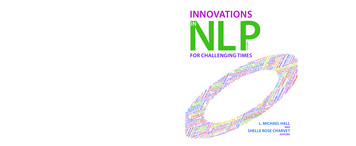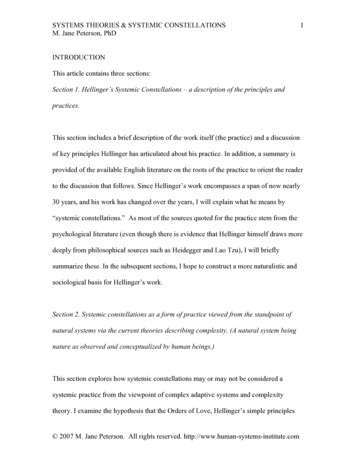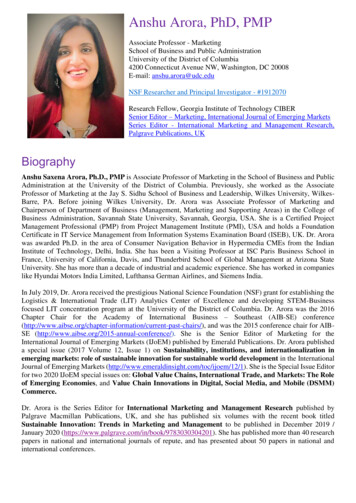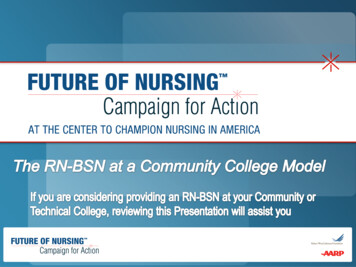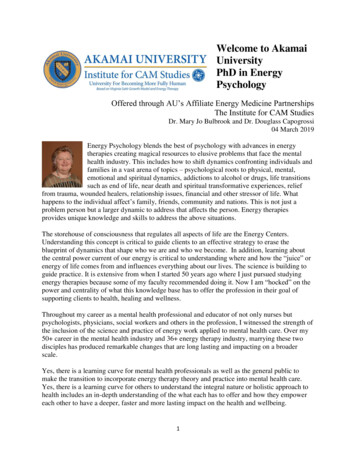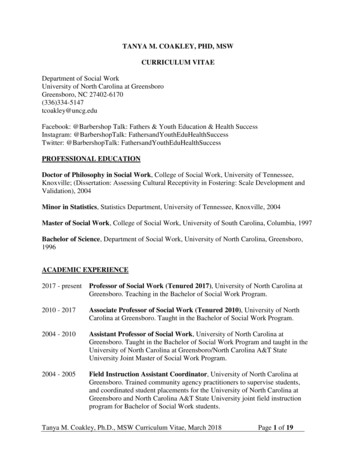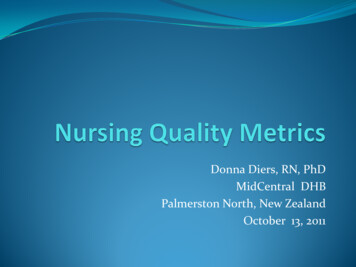
Transcription
Donna Diers, RN, PhDMidCentral DHBPalmerston North, New ZealandOctober 13, 2011
Nursing Quality MetricsCanada: C-HOBIC (Canadian Health Outcomes forBetter Information and Care)* Acute careADL; Bladder continence; Pain (frequency/intensity);Fatigue; Dyspnea; Nausea; Falls; Pressure ulcers;Therapeutic Self Care (TSC)All converted to scores: range 0-67; higher dependent Long term care/Complex Continuing CareSame fields without TSC.* www.cna-aiic.ca/c-hobic/about/default e.aspx
Nursing Quality MetricsNDNQI: The National Database of Nursing QualityIndicators (www.nursingquality.org)Other indicatorsNSQIP and specialty-specific indicatorsEpidemiology - reportable conditionsHealthy People 2020Patient Satisfaction surveysEmployee opinion surveysOutcomes Potentially Sensitive to Nursing (OPSN)
NDNQI: The National Database ofNursing Quality IndicatorsProprietary product of the American Nurses’Association in collaboration with the University ofKansas School of Nursing (since 1998)NDNQI indicators are part of the National QualityForumAssociated with the Magnet Hospital Program
Present Indicators (2011-12) Nurse staffing RN Education/Certification Nurse Turnover Falls Pressure ulcers Restraint use Physical/sexual assault Peripheral Intravenous (PIV) Infilrations (peds only) Pain Assessment/Intervention (AIR) cycles (peds only)
Present Indicators (con’t) Healthcare –associated infectionsCentral Line Associated Blood Stream InfectionsUmbilical Catheter Associated Blood StreamInfectionsCatheter Associated Urinary Tract InfectionsVentilator Associated Pneumonia (newbornsonly)
NDNQI services Unit-level comparison data, deidentified, data suppressed if 5cases or units reporting Benchmarks to academic medical centers, hospitals with beds 500 and/or Magnet hospitals Quarterly reports benchmarked to mean, median, 25% and 75% Staff support; client input; data available for research Cost: 10,000 per hospital per year
Details Unit level data by unit type-Adult Critical Care-Adult Step Down-Adult Medical-Adult Surgical-Adult medical/surgical combined-Adult (physical) rehab(con’t)
Unit types (con’t) Adult onlyAdult MedicalCardiacNeurologyOncologyAdult surgicalCardiothoracicNeurosurgeryOrthopedicAdult Medical/surgicalCardiacNeuro/NeurosurgeryOncology
Unit types (con’t) Adult Only Burn Unit Cardiothoracic ICU Coronary ICU Medical ICU Neuro ICU Pulmonary ICU Surgical ICU Trauma ICU
Unit types con’t Pediatric Critical CarePediatric Step DownPediatric MedicalPediatric SurgicalPediatric Med-Surg combinedPediatric RehabLevel I, II, or III NeonatalWell baby nurseryAdult PsychiatricGeripsychChild and/or Adolescent PsychiatricOther psychiatricCritical Access UnitObstetricsEmergency DepartmentIssue: fit with individualhospital’s units
Nurse staffing metrics: 1Nursing Hours Worked per Patient Day by job categoryRNRequires censusLPN/LVNthree times/dayUnlicensed assistive personnelTotalOnly “productive” hours counted“Patient days are adjusted for short stay patients whenhospitals are able to do so.”
Nursing staffing metrics: 2Skill mix: distribution of nursing hours by job category% RN% LPN/LVN% UAP“Agency hours” are included and then separated by jobcategory
RN Education% BSN or higher degree% with national certificationIssue: collecting and updating this information andattributing nurses to units
Patient Metrics: FallsFalls (by unit) per 1,000 patient daysInjury falls per 1,000 patient days (all fall categories)% of falls that were moderate or greater injuryFalls characteristics (assisted/unassisted)/1,000 pt daysNursing process for fall preventionPrior fall risk assessmentRisk assessment within last 24 hoursAt riskAt risk and fall protocolRestraints in use at time of fall
Patient Metrics: pressure ulcersAll collected by prevalence study once per quarter% of patients with pressure ulcers% of patients with hospital acquired pressure ulcers% of patients with hosp. acq. PU Stage II and above% of patients with UNIT acquired PU% of patients with UNIT PU Stage II and abovePressure ulcer prevention for patients at risk (24 hrs)Skin assessment, pressure reducing surface,repositioning, nutritional support, moisture mgmnt
Process Metrics: Restraints% of patients with physical restraint (prevalence)Issue: combinewith PUprevalence?IndicationsdefinitionsRestraint characteristics:LimbVestLimb and vestMedical/surgical indications for restraintBehavioral indications for restraintClinical justification for restraint
Nurse Turnover Nursing Unit turnover rate as % of employed FTE Nursing Unit turnover rate as % of employed staff Voluntary nursing unit turnover rate by job class Average years of tenure of staff who leave Controllable/uncontrollable reasons (only for Magnet)
Physical/Sexual Assault Injury assault rate per 1,000 patient days Total assault rate Patient characteristics (age, gender, involuntaryadmission) Characteristics of injury assaultsMedian time since admission% within 24 hours of admission% repeated assaultsMean number of assault victims per episode% nurse victims
Assault con’t Job classification of injured persons (incl. visitor) Injury level most severely injured person (RN, nonRN) Characteristics of nurse victims Years psych nursing experience% with assault management training Post assault interventions Restraint types and duration of restaint andseclusion
Peripheral IV infiltrationPrevalence study % of PIV sites with infiltrationsIssue: combinewith PU andrestraintprevalence? Peripheral IV characteristicsTotal patients with PIV% of patients with 1 PIV site% of PIV sites with a vesicant solutionIV site distribution
Pain Assessment/AIR CyclesQuarterly one-day retrospective chart review Average number of pain assessments per patient Nursing process for patients assessed for painNumber of pain assessmentsPercent of cycles completedComponents missing from incomplete cycles Pain intervention profile
Healthcare associatedInfections Central line associate blood stream infections(CLABSI) per 1000 Central line days CLABSI by birthweight category 750 gm751-1000 gm1001-1500 gm1501-2500 gm 2500 gmIssue: how getcentral line days ifno EMR?
Healthcare associatedinfections (con’t) Umbilical catheter associated blood stream infectionsper 1000 umbilical catheter days Same birthweight categories
Healthcare associatedinfections (con’t) Non-umbilical central line associated blood streaminfections per 1000 non-umbilical central line days Same birthweight categories
Healthcare associatedinfections (con’t) Catheter associated urinary tract infections (CAUTI)per 1000 catheter days Ventilator associate pneumonia (VAP) per 1000ventilator days VAP by birthweight categories
Where are we going withthis?
The Very Big ment
NURSING UNITDATAFORQUALITY ANDSAFETY
Data on Nursing Resources I Nursing hours (caregiver hours) per patient dayPayroll or rostering systemBy shift, day of week Nursing qualifications (degrees, experience,certification)Need to build data systems for this Vacancies and turnoverBenchmarkedHR data systems
Data on Nursing Resources II Support available:Non-licensed staffAccess to specialized nurses/NP’sWard secretarial supportFacilities supportBusiness supportPayroll, rostering, HR systems
Data on Nursing Workload I “Acuity” measurementHomegrown or purchased systems “Churn”Patient activity systems Number of patients in isolationEMR; hospital epidemiology; prevalence study Number of different case types (DRGs)NZHIS submission? Unit level data?
Data on Nursing Workload II Number of physicians or physician teamsEMR or patient medical records Presence of learners (housestaff; nursing students)Personnel records Psychiatric or substance abuse secondary diagnosesEMR or medical records coding Number of patients awaiting placementEMR or retrospective discharge and LOS dataEtc. Etc.
Data on the WorkingEnvironment Nursing Work Index (NWI) or similar surveys Geography of the unit Perception of potential for violence/assault Organizational “health” (from observation) Leadership Interprofessional relationships “Economics” of the unit – over/under budget? Employee satisfaction surveys Etc. Etc.
Data on Process Evidence based practice protocols/guidelines Models of care QI/process improvement strategies/tactics Patient/family orientation Cultural safety Interdisciplinary rounds Shared governance Etc. Etc.
Data on Patient Outcomes Adverse events Nursing-sensitive measuresNDNQI-type measuresInitiation of breast feedingWaiting times in EDAntibiotics before surgery or C-sectionReadmission ratesOutcomes Potentially Sensitive to Nursing (OPSN) Patient satisfaction
Data on Nurse Outcomes Intent to stay/leave the position (surveys) Intent to stay/leave nursing (surveys) Employee satisfaction surveys Work injuries Assaults/patient violence toward staff Time to fill vacant positions Leadership turnoverEtc. etc.
Data on OrganizationalOutcomes Length of stay Readmission rates Transfers to other facilities Ambulance diversions ED waiting times Cost per case Cost per day Results of inspections Etc. Etc.
NURSINGRESOURCESNurseOutcomesWorkingEnvironment
Questions?Comments?
Thank you for your attention
Therapeutic Self Care (TSC) All converted to scores: range 0 -67; higher dependent . Associated with the Magnet Hospital Program . . % LPN/LVN % UAP “Agency hours” are included and then separated by job category . RN Educati
